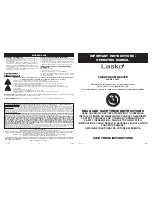
If draft of –0.02" WC cannot be produced with an existing vent system, a draft inducer may be
required. Installations common vented with large vent hood equipped appliances such as
heating boilers may require vent dampers on the heating boiler connectors for proper vent
operation during summer months.
Check the building for items that can cause severe negative pressure problems such as large
exhaust fans. If these devices are installed in the same building check for their effect on draft
and combustion. All fuel burning appliances must be isolated from the effects of these devices
to operate properly. Failure to address this issue will result in unsafe operation and shorten
appliance life spans.
Your Bock Water Heater may also be operated with a power venter. The power venter must be
properly sized and adjusted to provide proper draft. Power venter wiring must turn on the
power venter on a call for heat and must prove venter operation before allowing the burner to
start. Refer to the power venter instructions for proper wiring and adjustment procedures.
CONNECT WATER PIPING
Connect cold inlet and hot outlet to fittings on top of water heater except models 33PG and
40PG. These models have cold water inlets located on the side of the tank. See drawing and
note below. Be careful not to apply any heat to the water heater nipples. Install dielectric
unions and shut off valves on both hot and cold water lines. Models 72PG through 541PG
have larger fittings located on the side of the tank or under the drain valve for use
as recirculation/return connections. Larger return fittings are optional on smaller models.
Alternatively recirculation/return lines can be plumbed to the cold water inlet.
33PG and 40PG models are equipped with a brass inlet
bushing installed in the tank. Heaters equipped with this
bushing are marked next to the inlet by the decal shown
on the left. The purpose of this bushing is to help keep the
tank bottom free of sediment by aiding tank flushing.
This bushing must be located as shown on the decal to
function properly. Do not allow the bushing to rotate out
of position when tightening the inlet fittings.
An approved pressure and temperature relief valve is factory installed in the opening provided
in the upper right-hand side of the water heater. Pipe the T&P valve outlet to within 6" of the
floor or to a floor drain with a free flowing drain pipe.
CAUTION: Scalding injury and/or water damage can occur from either the manual lifting
of the lever or the normal operation of the T&P valve if it is not piped to a proper drain.
If the valve fails to flow water or reseat, call your plumber.
Check incoming water line for backflow preventers or water pressure reducing valves, as these
may cause pressure to build up in the water heater and result in tank failure. If this water
heater is installed in a closed system or if backflow preventers and pressure regulators are
installed, a properly sized expansion tank must be installed.
Note:
Do not try to heat hard water as this will drastically reduce heater life. Install a water
softener or other scale reducing water treatment system if the water heater is being installed in
a hard water area (water hardness higher than seven grains).
BURNER AND AQUASTAT INSTALLATION
Remove the cardboard core from the burner opening in the water heater. Inspect the burner
opening in the water heater and verify that the chamber is aligned with the burner opening
and has not shifted in shipment. Also verify that the chamber and insulation has not been
damaged in shipment. Some burner models are equipped with adjustable mounting flanges.
When installing these burner models measure the distance from the inside bottom edge of the
combustion chamber to the burner mounting bracket on the water heater jacket. Subtract
1
⁄
8
"
from this measurement and locate the burner mounting flange that distance from the end of
Page 6
Power Gas






























